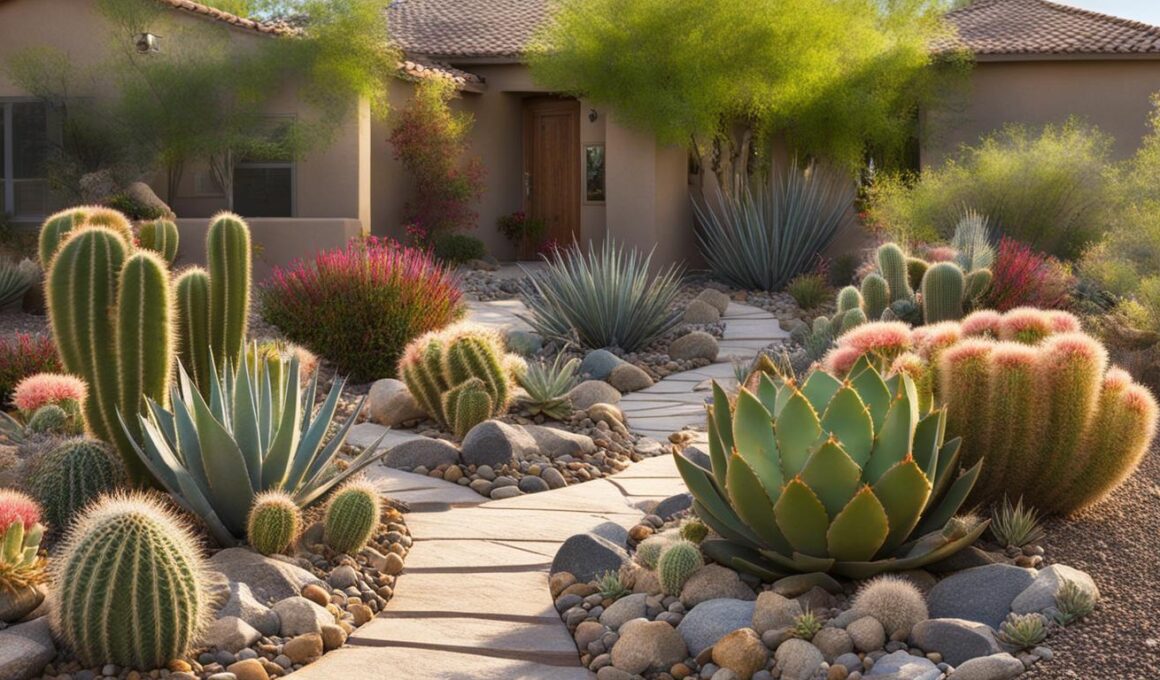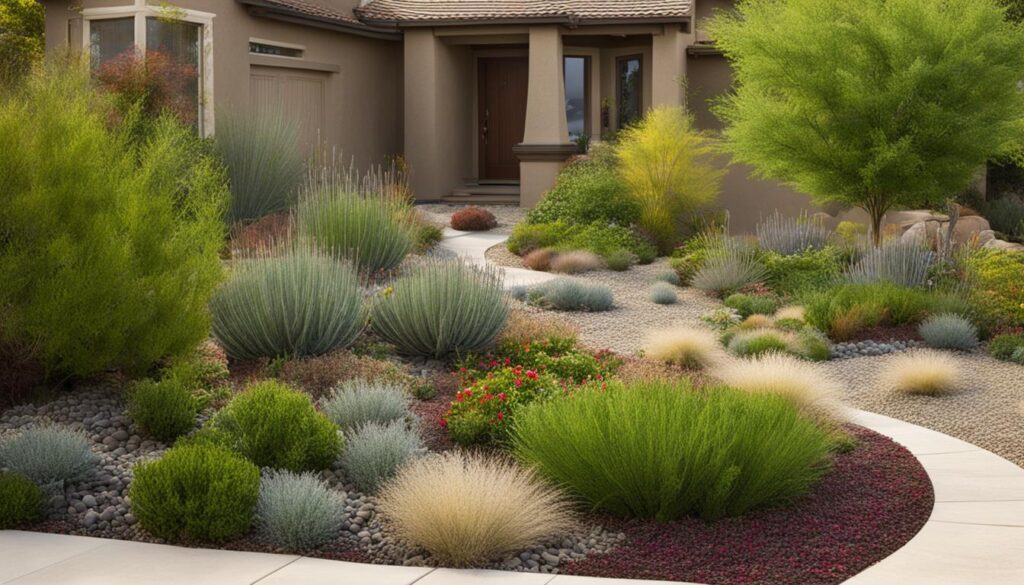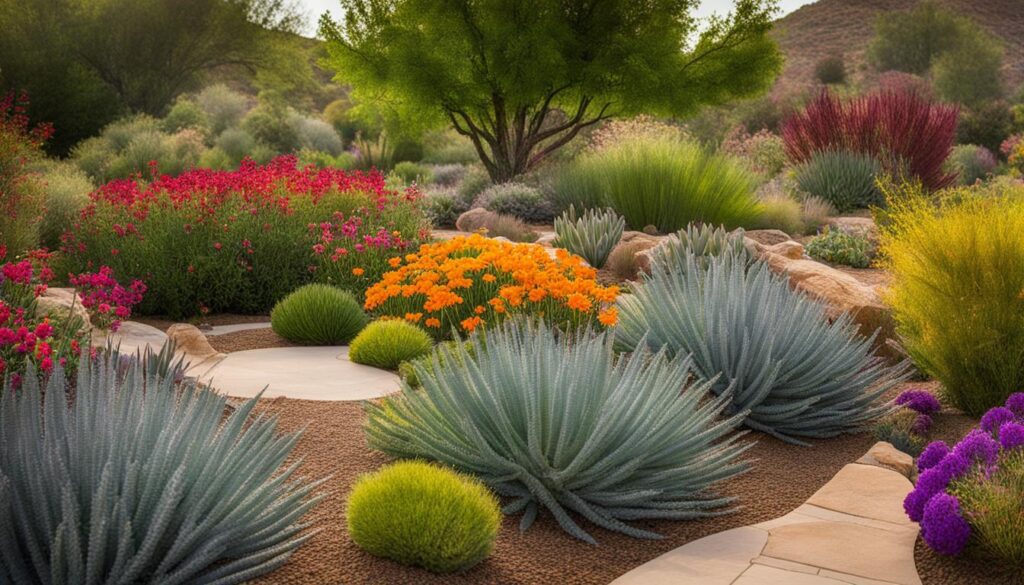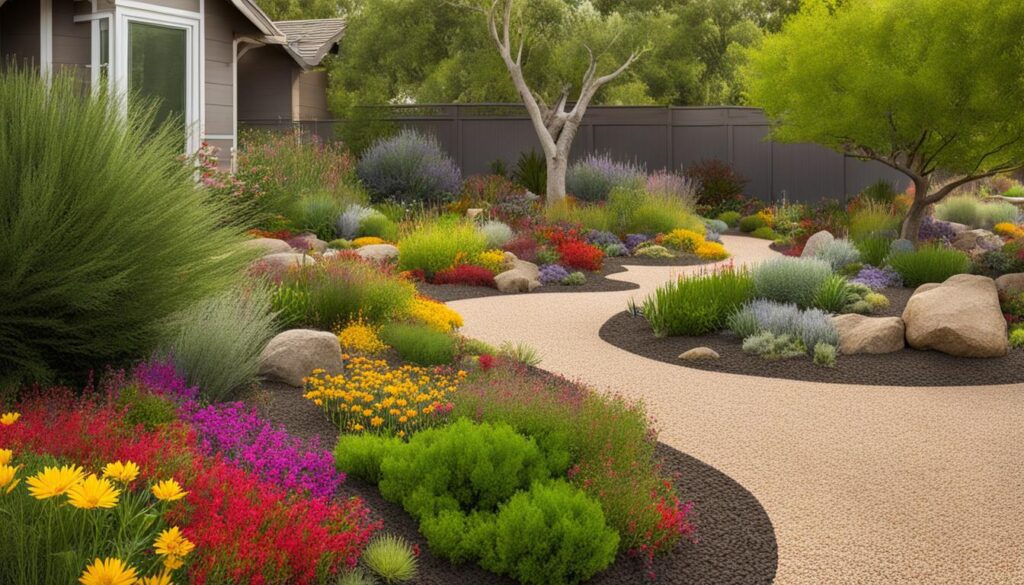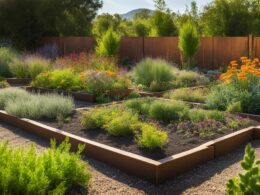Sustainable xeriscaping is a landscaping method that aims to use as little water as possible while still maintaining aesthetically pleasing and eco-friendly landscapes. It has gained popularity in regions facing water scarcity and is a great solution for reducing water consumption in outdoor spaces. By utilizing drought-tolerant plants and implementing water-saving techniques, sustainable xeriscaping helps conserve water resources while creating beautiful landscapes.
Key Takeaways:
- Sustainable xeriscaping is a landscaping method that conserves water resources.
- It involves using drought-tolerant plants and implementing water-saving techniques.
- Xeriscaping is particularly beneficial in regions facing water scarcity.
- By reducing water consumption, xeriscaping promotes eco-friendly landscaping.
- Sustainable xeriscaping creates visually appealing outdoor spaces while conserving water.
What is Xeriscaping?
Xeriscaping is a landscaping method that focuses on reducing or eliminating the need for irrigation. It is a sustainable and water-efficient approach to creating beautiful outdoor spaces that require minimal maintenance. The concept of xeriscaping originated in the western United States in response to prolonged droughts and limited water resources. By incorporating native, drought-tolerant plants and implementing water-saving techniques, xeriscaping promotes water conservation while still providing aesthetically pleasing landscapes.
Unlike traditional landscaping methods that rely heavily on watering, xeriscaping aims to create landscapes that can thrive with minimal irrigation. Native plants are a crucial component of xeriscaping as they are naturally adapted to the local climate and require less water to survive. These plants are typically drought-tolerant and can withstand dry conditions, making them ideal for water-efficient landscaping.
“Xeriscaping is about using as little water as possible while still achieving a visually appealing landscape.”
In addition to using native plants, xeriscaping incorporates other water-saving techniques. These include mulching, which helps retain moisture in the soil, and implementing efficient irrigation methods such as drip systems and soaker hoses. By reducing the amount of water used in outdoor spaces, xeriscaping not only conserves water resources but also helps homeowners and businesses save on water bills.
Benefits of Xeriscaping
Xeriscaping offers a multitude of benefits that make it an attractive landscaping choice, especially when it comes to water conservation. By incorporating drought-tolerant plants and implementing efficient irrigation methods, xeriscaped landscapes can significantly reduce water consumption. Compared to traditional grass lawns, xeriscaping can lower water usage by 50% or more. This not only helps conserve precious water resources but also leads to cost savings on water bills.
Furthermore, xeriscaping has a positive environmental impact. By eliminating the need for excessive watering, it reduces the demand for fertilizers and pesticides, which can harm the environment. Additionally, xeriscaped landscapes minimize the use of gas-powered mowers, reducing air and noise pollution. The reduction in water usage also helps alleviate the strain on local water sources and supports water sustainability in regions prone to drought.
Another benefit of xeriscaping is its contribution to biodiversity and habitat preservation. By using native plants, xeriscaped landscapes provide a natural habitat for local wildlife, such as birds, butterflies, and bees. This promotes biodiversity and helps maintain the delicate balance of ecosystems. Xeriscaping allows you to create a beautiful outdoor space while actively supporting and preserving the local ecosystem.
Key Benefits of Xeriscaping:
- Significant water conservation
- Cost savings on water bills
- Positive impact on the environment
- Reduction in the use of fertilizers and pesticides
- Minimization of air and noise pollution
- Support for water sustainability
- Promotion of biodiversity and habitat preservation
By embracing xeriscaping, you not only create a visually appealing landscape but also contribute to water conservation efforts, save money, and help protect the environment. Whether you are a homeowner, business owner, or landscape designer, implementing xeriscaping practices can bring multiple benefits while creating sustainable and beautiful outdoor spaces.
Xeriscaping Design: Creating Water-Efficient Landscapes with Native Plants
Designing a xeriscaped yard involves careful consideration of the local climate, water availability, and the selection of appropriate plants. By utilizing native plants and implementing water-efficient landscaping techniques, you can create a beautiful and sustainable outdoor space that requires minimal irrigation.
One of the key elements in xeriscaping design is the use of native plants. Native plants are adapted to the local climate and soil conditions, making them naturally drought-tolerant and well-suited for water-efficient landscapes. These plants have the ability to thrive with minimal irrigation, reducing the need for excessive watering.
When selecting native plants for your xeriscaped yard, consider their water requirements, growth habits, and overall aesthetic appeal. Choose a variety of plants that bloom at different times of the year to ensure year-round beauty. By incorporating a mix of trees, shrubs, grasses, and flowers, you can create a visually appealing and diverse landscape that attracts native wildlife and promotes biodiversity.
Water-Efficient Landscaping Techniques
In addition to plant selection, there are several water-efficient landscaping techniques that can be incorporated into the design of a xeriscaped yard:
- Group plants with similar water needs together to create efficient irrigation zones.
- Use mulch around plants to reduce evaporation and conserve soil moisture.
- Implement drip irrigation or soaker hoses to deliver water directly to the roots, minimizing water waste.
- Collect and utilize rainwater through rain barrels or cisterns for irrigation purposes.
- Design the landscape to capture and retain rainwater, preventing runoff and maximizing water absorption.
By incorporating these techniques, you can maximize water efficiency in your xeriscaped yard and create a sustainable and beautiful landscape that requires less maintenance and water.
Achieve a Water-Efficient Landscape with Xeriscaping
“Xeriscaping design is all about creating water-efficient landscapes that not only conserve water but also enhance the natural beauty of the environment. By selecting native plants, implementing water-saving techniques, and embracing the principles of xeriscaping, you can create a yard that thrives with minimal irrigation and provides a haven for local wildlife.” – Jane Smith, Landscape Designer
In conclusion, designing a xeriscaped yard involves careful planning and consideration of the local environment. By choosing native plants, implementing water-efficient landscaping techniques, and embracing the principles of xeriscaping, you can create a sustainable and visually appealing outdoor space that conserves water and enhances the beauty of your surroundings.
Xeriscaping Success Stories
Discover inspiring xeriscaping success stories that showcase the beauty and sustainability of water-saving landscapes. These real-life examples demonstrate how homeowners and businesses have transformed their outdoor spaces into thriving gardens while conserving water resources.
“After implementing xeriscaping techniques, my once water-intensive lawn has been transformed into a vibrant and eco-friendly oasis. With the use of native plants and efficient irrigation methods, I’ve significantly reduced my water consumption without compromising on visual appeal.”
One success story comes from John, a homeowner in a region prone to drought. Through xeriscaping, he was able to create a low-maintenance and sustainable garden that not only preserved water but also attracted native wildlife. John’s xeriscaped yard features drought-tolerant plants, mulch, and a drip irrigation system, all of which contribute to the success of his water-saving landscape.
Another success story is from GreenTech Solutions, a landscaping company specializing in sustainable gardening. By implementing xeriscaping practices in their projects, they have helped numerous clients create beautiful and water-efficient landscapes. Their team of experts combines native plants, smart irrigation systems, and proper soil management to ensure the long-term success of their xeriscaped designs.
Creating Sustainable Landscapes
These success stories highlight the positive impact of xeriscaping in promoting sustainable gardening practices. By embracing xeriscaping techniques, you can not only reduce water consumption but also create visually stunning outdoor spaces that are both environmentally friendly and cost-effective.
- Save water: Xeriscaping can reduce water consumption by up to 50% compared to traditional lawns.
- Minimize maintenance: With drought-tolerant plants and efficient irrigation systems, xeriscaped landscapes require less maintenance.
- Promote biodiversity: Native plants in xeriscaped gardens provide habitat for wildlife and contribute to biodiversity conservation.
- Lower costs: By reducing water usage, xeriscaping can lead to significant savings on water bills.
Whether you’re a homeowner, a business owner, or a landscaping professional, implementing xeriscaping practices can contribute to a more sustainable future while creating beautiful and water-saving landscapes.
Xeriscaping and Climate Change
With climate change leading to more frequent and severe droughts, xeriscaping is a valuable tool for water management. By utilizing drought-resistant plants and minimizing water use, xeriscaped landscapes can withstand the challenges of water scarcity. Xeriscaping also helps mitigate the urban heat island effect by incorporating shade trees and reducing the need for water-intensive grass lawns.
According to the Environmental Protection Agency, water scarcity is a growing concern in many parts of the United States. By implementing xeriscaping practices, you can make a significant contribution to water conservation efforts. Xeriscaping allows you to create a sustainable and beautiful outdoor space without relying heavily on irrigation.
“Xeriscaping is an effective strategy for combating the water shortage caused by climate change. By choosing native drought-resistant plants and using water-efficient landscaping techniques, you can create a resilient and eco-friendly landscape that requires minimal water. It’s a win-win situation for both the environment and your water bill.”
The benefits of xeriscaping in combating climate change include:
- Reduced water consumption and conservation of water resources
- Lower water bills and potential cost savings
- Minimized use of fertilizers, pesticides, and gas-powered mowers
- Promotion of biodiversity and habitat for native wildlife
- Creation of aesthetically pleasing and low-maintenance landscapes
As climate change continues to impact water resources, xeriscaping offers a sustainable solution for maintaining beautiful outdoor spaces while conserving water. By embracing xeriscaping practices, you can play a crucial role in mitigating the effects of climate change and ensuring a greener future.
Implementing Xeriscaping Practices
Implementing xeriscaping practices is key to creating a water-efficient and sustainable garden design. By following these steps, you can transform your outdoor space into an eco-friendly oasis:
- Assess your local climate, soil conditions, and water availability. Understanding these factors will help you choose the right plants and irrigation methods for your xeriscaped landscape.
- Prioritize native and drought-tolerant plants. These species are well-adapted to the local environment and require less water to thrive. Incorporate a variety of plants with different heights, textures, and colors to create visual interest.
- Utilize mulch to conserve moisture in the soil. Apply a layer of organic mulch, such as wood chips or straw, around your plants to reduce evaporation and suppress weed growth.
- Install efficient irrigation systems. Drip irrigation is particularly effective for xeriscaping, as it delivers water directly to the plant’s roots, minimizing waste. Consider using smart irrigation controllers that adjust watering schedules based on weather conditions.
Regular maintenance and monitoring are crucial to the long-term success of your xeriscaped landscape. Keep an eye out for signs of plant stress or pests and make any necessary adjustments to your irrigation system. With proper implementation, xeriscaping can significantly reduce your water consumption while creating a beautiful and sustainable outdoor space.
What are the Best Water-Efficient Irrigation Systems to Use in Sustainable Xeriscaping?
When it comes to sustainable xeriscaping, using waterefficient xeriscape irrigation systems is essential. Drip irrigation, soaker hoses, and rainwater harvesting are some of the best options. These systems help conserve water while keeping your xeriscaped garden healthy and thriving, even in arid climates.
Conclusion
Sustainable xeriscaping is a valuable approach to water management and creating eco-friendly landscapes. By implementing water-saving techniques and utilizing drought-tolerant plants, xeriscaping helps reduce water consumption while still maintaining visually appealing outdoor spaces. This not only benefits the environment but also contributes to water conservation efforts.
With the increasing water scarcity and the impact of climate change, xeriscaping offers a sustainable solution for outdoor spaces. By conserving water resources and reducing the need for irrigation, xeriscaped landscapes can withstand the challenges of water scarcity and contribute to a more resilient environment. By embracing sustainable xeriscaping, you can play a role in water management and contribute to the mitigation of the effects of climate change.
Moreover, xeriscaping promotes eco-friendly landscaping practices. By minimizing the use of fertilizers, pesticides, and gas-powered mowers, xeriscaped landscapes have a positive environmental impact. In addition, xeriscaping promotes biodiversity by providing habitat for native wildlife. By creating a sustainable garden through xeriscaping, you can have a beautiful and low-maintenance outdoor space that benefits both you and the environment.





